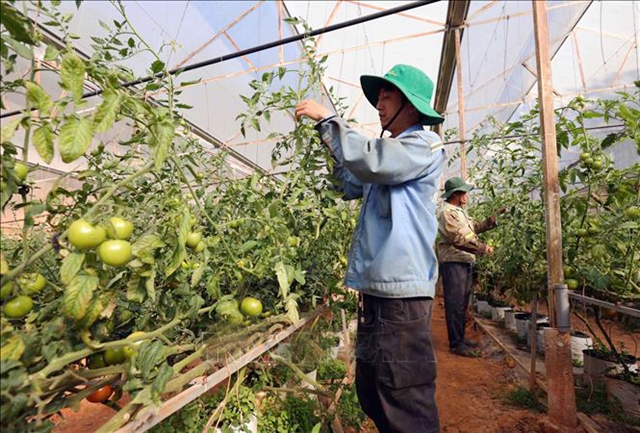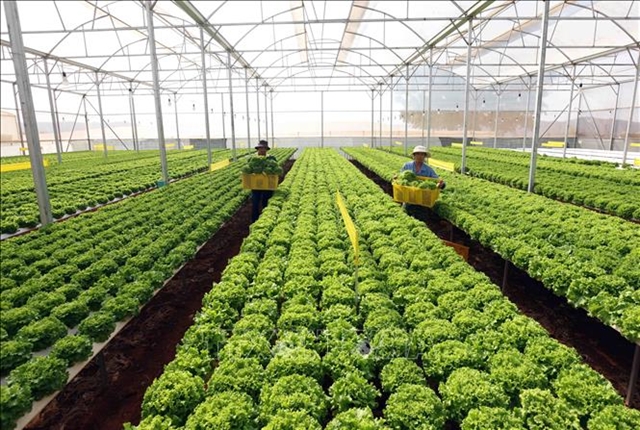 Society
Society


|
| The Tân Tiến Agricultural Service Co-operative in Lâm Viên - Đà Lạt Ward in Lâm Đồng Province cultivates various vegetables and fruits, harvesting more than 3,000 tonnes annually. – VNA/VNS Photo Vũ Sinh |
LÂM ĐỒNG – Agricultural co-operatives in Lâm Đồng Province have become a key driver in promoting commodity production, increasing agricultural value and expanding export markets, according to the provincial Department of Agriculture and Environment.
Located in the South-Central Coastal–Central Highlands region and having the largest land area in the country, Lâm Đồng now has more than 1,000 co-operatives, including over 600 agricultural ones.
Many agricultural co-operatives have gradually built value chains, applied science and technology, and produced under VietGAP, GlobalGAP, and organic standards, thereby improving productivity, product quality, and members’ and farmers’ incomes.
Võ Đình Danh, director of the Đắk Mil Agroforestry Co-operative in Đức Lập Commune, said: “Our co-operative guides members to grow high-quality coffee under a value-chain model. With support from local authorities and the provincial Co-operative Alliance, we have steadily developed stable production and business.”
Nguyễn Thị Ngọc Sen, director of the Agricultural Production and Purchasing Co-operative in Bắc Gia Nghĩa Ward, said the co-operative has invested in greenhouses and applied technology to grow honeydew melons and tomatoes, helping increase productivity and reduce labour costs.
The co-operative earns profits of over VNĐ100 million (US$3,800) per 1,000 sq.m each year, several times higher than traditional farming, she said.
Many co-operatives in the province use automatic irrigation, moisture sensors, farm management software, and product traceability systems.
These technologies improve productivity, quality, and brand reputation.
Hundreds of clean agricultural products in the province are sold in major supermarkets nationwide and exported to Japan, South Korea, and the EU.
Co-operatives bring not only profits but also sustainability.
The Công Bằng Thuận An Co-operative in Thuận An Commune has invested in three coffee processing plants.
These facilities help control quality and diversify products, from raw coffee beans to ground coffee, for both domestic and export markets.
The co-operative has maintained an average annual revenue of around VNĐ33 billion ($1.3 million) over the past five years.
Nguyễn Hữu Hạ, director of the co-operative, said: “We organise good production contests for members to encourage creativity and innovation in coffee cultivation. Outstanding members are given opportunities to visit and learn from effective models at home and abroad.”
Nguyễn Thị Minh Trí, a member of the co-operative, said: “With technical support from the co-operative, my family has improved our coffee orchard and stabilised our income.
“The co-operative buys our coffee at VNĐ1,200 per kilogramme above the market price. We are also provided with free bio-fertiliser, which reduces chemical use, protects the environment, and enhances product quality.”
Linkages between co-operatives and processing or exporting enterprises have proved highly effective.
Lê Anh Sơn, director of the Bình Minh Co-operative in Đắk Wil Commune, said: “Linking with enterprises helps us produce pepper in a professional and sustainable way.
“The co-operative implements international certifications like Rainforest Alliance and Farm Sustainability Assessment, expanding raw material areas and ensuring stable output.”

|
| The Gia Nguyễn Lâm Đồng General Agricultural Co-operative in Lâm Đồng Province’s Quảng Lập Commune grows more than 50ha of hydroponic vegetables. – VNA/VNS Photo Vũ Sinh |
Developing exemplary co-operatives
Lâm Đồng has selected 15 agricultural co-operatives to join a project supporting the development of exemplary and effective agricultural co-operatives.
They include Vườn Nhà Đà Lạt General Agricultural Service Co-operative in Xuân Trường - Đà Lạt Ward, An Phú General Agricultural Service Co-operative in Hiệp Thạnh Commune, Thuận Tiến Dragon Fruit Co-operative in Hàm Liêm Commune, Hòa Lệ Clean Dragon Fruit Co-operative in Hàm Thuận Commune, Đắk Mil Agroforestry Co-operative in Đức Lập Commune, and Nam Hà Agroforestry Co-operative in Cư Jút Commune.
After joining the project, these co-operatives have had stable farm contracts, adopted advanced technologies, and applied VietGAP, GlobalGAP, and organic standards, according to the Department of Agriculture and Environment.
Many products of these co-operatives have been recognised under the country’s “One Commune – One Product” programme, enhancing local agricultural brands, creating rural jobs for women and youth, and contributing to new-style rural area development.
Bùi Hoa Thám, deputy chairman of the provincial Co-operative Alliance, said: “The Fourth Industrial Revolution is creating a turning point in production and consumption. Therefore, we encourage co-operatives to accelerate digital transformation and apply new technologies.”
“Developing co-operatives aims not only at economic goals but also at human values. It helps build united communities, maintain political stability, ensure national defence and security, and create a resilient collective economy adaptable to modern trends.”
The province aims to develop co-operatives following a modern model in the coming period, focusing on operational quality, expanding new-style co-operative models, and strengthening value-chain linkages between co-operatives and enterprises.
It will prioritise policies for agricultural co-operatives applying high technology and encourage investment in potential sectors such as processing industries, logistics services, and agricultural tourism.
It will continue to improve support mechanisms and policies, expanding access to resources for co-operatives, especially in agriculture, rural areas, and the marine economy.
It targets that 45 per cent of co-operatives will be linked with enterprises through value chains by 2026. – VNS




